The ikat process
Ikat is an ancient technique used to pattern textiles. The defining characteristic of ikat is the dyeing of patterns before the weaving of the fabric takes place. The patterns are created by means of a resist dyeing process on either the warp or weft fibres, or on both. We will here look at cotton warp ikat, the technique most common in the Indonesian archipelago.Spinning, where it all begins
One of the most fundamental skills required to produce a high quality ikat, is spinning. While spinning wheels have been introduced in some parts of Indonesia, spindle spinning is still practiced in many parts, especially on the more remote islands, such as here on Alor. In that respect not much has changed since 1932 when Ernst Vatter wrote in Ata Kiwan: "... in those areas where there still is much weaving, you rarely see women or older girls without their 'handiwork', the spindle, which they diligently spin during every pause that their other work allows."The thread produced by means of a gravity or drop-weight spindle is called benang putar, and textiles made of it are generally highly appreciated, both by locals and by collectors. The evenness of thread that an experienced spinner can achieve with a spindle is stunning, yet one can always feel the difference between commercial, factory made yarns and hand spun yarns by passing it through the fingers and paying attention to the minute differences in thickness that betray the old handwork.
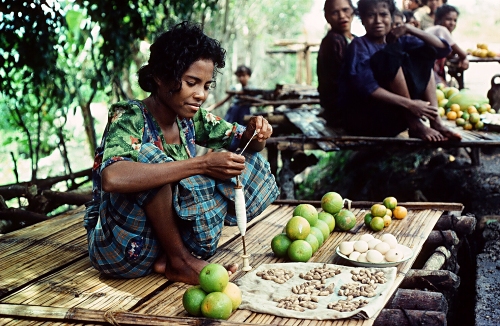
Woman on a market near Kalabahi, Alor, making use of a slack time to do some spinning with her drop-weight spindle. Photo Peter ten Hoopen, 1981.
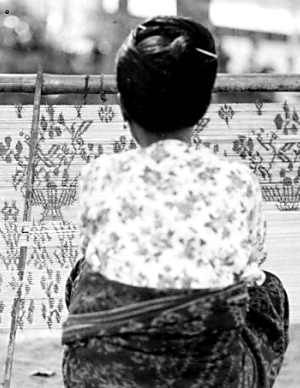 |
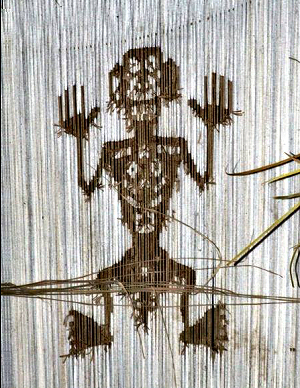 |
|
| Bindings applied to bundles of warp threads create the first resists on set of warp threads. Flores, probably the Sikka region. Anonymous, early 20th C. Tropenmuseum of Royal Tropical Institute (KIT), CCL. |
Ancestor pattern ikated in preparation of dye bath.
Rindi, Sumba. Photo courtesy Georges Breguet, 2006. |
|
Bindings that resist liquid are placed before each dye bath
The ikat process proper begins with the warp threads being strung up on the loom, close together and properly tightened. Then the pattern is drawn on to them in outline using charcoal, crayon or sticks dipped in dye. In most regions the patterns are improvised, with various degrees of freedom and personal creativity, within a tightly prescribed traditional framework with determines the number and ordering of bands or stripes, their width, background colour, and overall patterning.Bindings that resist dye penetration are applied to narrower or wider bundles of threads (from as few as four in very fine ikat) in locations defined by the intended motif. In most parts of Indonesia these bindings are traditionally made of strips of palm or pandan leaf, raffia, or other plant material, which in some regions such as Borneo may be waxed with beeswax to improve impregnability, but these days plastic is also used, allowing greater definition.
Mordanting, if necessary, and dyeing
After the bindings required to protect all material that should not be coloured in the first round of dyeing are in place, the threads are taken off the loom and immersed in the dye bath - or, if the pigment is of a kind that does not spontaneously penetrate and adhere to the fibre, such as morinda, they are first soaked in a mordant, then dyed. Indigo, the most common colour in the Indonesian archipelago, is an ideal pigment to work with, as it adheres to cotton naturally, and is fully colourfast.After drying, the bindings are cut away, the threads are strung onto the loom again and arranged carefully so that they match exactly, and new bindings are put in place for all locations that should not receive colour in the second round of dying. Then the tied threads are taken off the loom again, immersed in the next dye bath - and so on until the desired multicoloured pattern has been created. The duration of the soaking of the threads in the dye bath varies from a day to several weeks. In many regions a particular dye bath may be repeated numerous times to achieve the desired intensity. A common technique to achieve more colour variation with a limited number of pigments is overdyeing, once or several times with bindings at different locations.
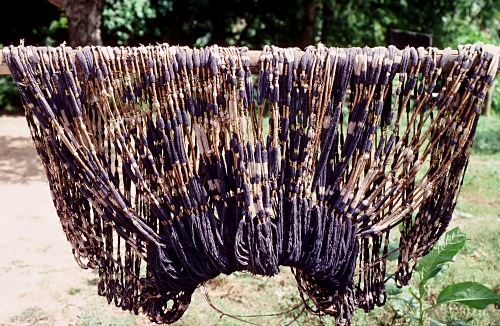
Warp of Sumba ikat drying after immersion in indigo. Ties that resist dye are still in place. Photo Peter ten Hoopen, 1981.
Arranging dyed warp threads on the loom
When the dyeing process is finished - which, because of ritual prescriptions, scarcity of material, or the need for multiple immersions in the mordant may take months or even years - the last bindings are removed and the threads are ready to be woven into cloth. The first step is to arrange the warp threads on the loom once again, taking great care to align them properly, so that the pattern comes out clear, well defined. Next to the intensity of the colouration, the clarity of the pattern is the most important indicator of craftsmanship.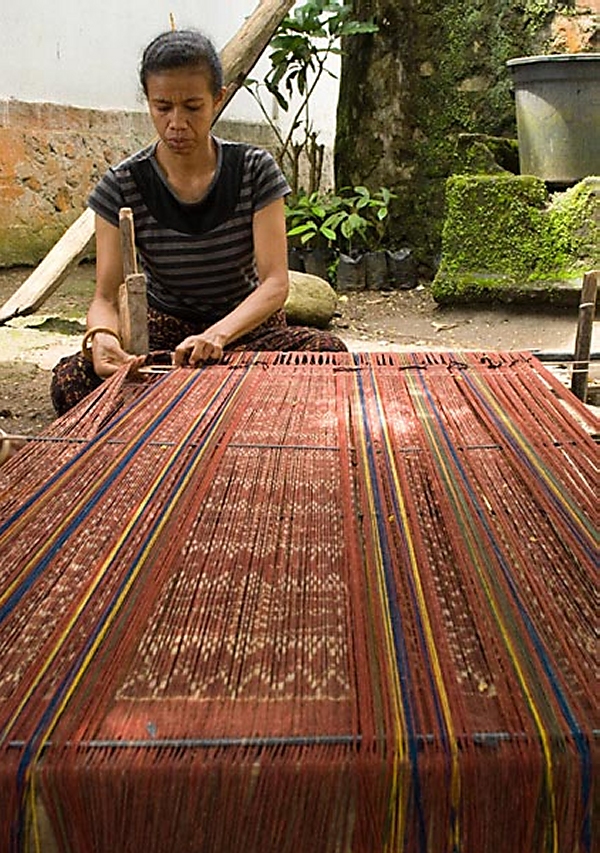
A weaver in Watublapi on Flores arranges the warp threads on the loom in preparation of weaving. Photo Chris Buckley, used by permission.
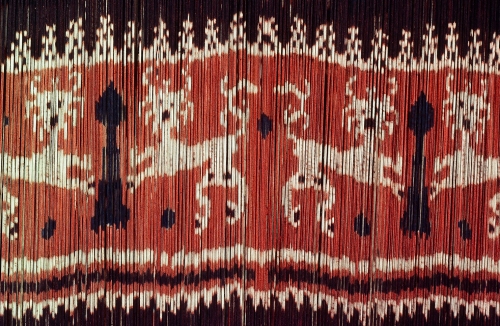
Warp for a Sumba hinggi ready for weaving, the design having been applied on the threads in three consecutive dye baths. Prior to the weaving in of the weft, the alignment of the individual warp threads still has to be adjusted to obtain a clear design.
In warp ikat the patterns are clearly visible in the warp threads on the loom even before the plain coloured weft is introduced to produce the fabric. In weft ikat it is the weaving or weft thread that carries the dyed patterns which only appear as the weaving proceeds. In weft ikat the weaving proceeds much slower than in warp ikat as the passes of the weft must be carefully adjusted to maintain the clarity of the patterns. In double ikat both warp and the weft are resist-dyed prior to stringing on the loom.
Finally: weaving, the end of the process
For the weaving of ikat cloth, traditionally, and still commonly, a backstrap loom is used, as below by this weaver on the island of Alor, though in principle any variant or modern loom might be used. The textiles in our collection have all been made in the traditional manner.The backstrap loom has been in widespread use in many parts of South and Southeast Asia since times immemorial. They are easy to construct from materials that are readily available in the natural environment. The warp threads are attached to two parallel wooden bars or sticks, one of which is either tied to stakes in the ground, or, in its most primitive form, held behind the feat of the weaver, and the other is attached to a belt around the weaver's waist.
This setup allows the weaver to relax or tighten the warp threads by a slight movement of the body either forwards, so as to facilitate the opening of the shed and the insertion of weft threads, or backwards to straighten out the cloth for inspection and adjustment of the thread alignment.
Backstrap looms come with an inherent limitation of width, namely the span of the weaver's arms. As a consequence all wider Indonesian ikat textiles consist of two or more panels stitched together along the selvages.
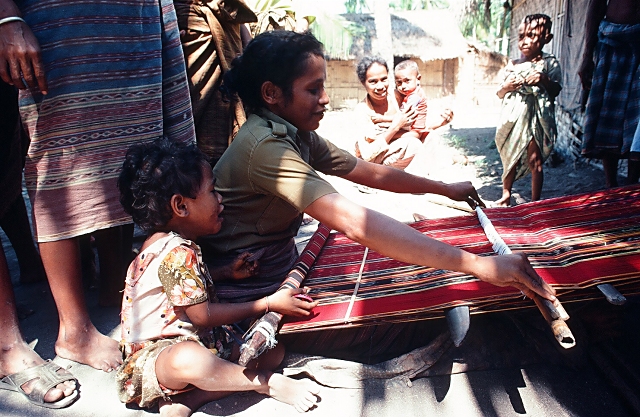 Woman on the island of Alor weaving an ikat sarong (unfortunately made with chemical dyes) on traditional backstrap loom. Photo Peter ten Hoopen, 1981.
Woman on the island of Alor weaving an ikat sarong (unfortunately made with chemical dyes) on traditional backstrap loom. Photo Peter ten Hoopen, 1981.
A tale of two pigments - plus friends
Probably about 90 percent of all ikat textiles in the region that we cover are coloured using just two pigments (except perhaps for a few narrow stripes in commercial thread). This magic duo consists of indigo and morinda, the one a deep blue, the other varying between brick red and the colour of blood (in fact closer to dried blood), with which it is often associated. By careful dosing of the ingredients, and especially by artful juxtaposition, they can create a wide range of tints, from muted and reticent tones to the most striking and energetic. Indigo is made from the leaves of Indigofera tinctoria or the closely related Indigofera suffruticosa, morinda from the roots of Morinda citrifolia and other variants. Morinda is especially hard to make, as about 30 kg of roots are required for a single cloth, an amount so large that it cannot always be harvested at the same time, so that the weaver may have spread the root-cutting over two or even three years. Both pigments are seen as imbued with magical powers, a seen as dangerous for the women who work with them, especially during the phase of preparation. To the Lamaholot similar taboos pertain to morinda, which they call mean (pronounced 'may-ahn'), the lifeblood of weaving in their area.By using just these two hallowed pigments, master dyers can achieve a whole range of colours: pale blue (by brief steeping in
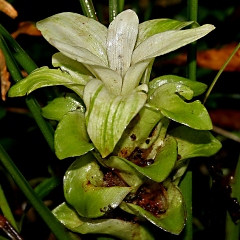 |
|
Kunyit plant, Turmeric longa. Photo J.M. Garg, GNU Free Documentation License. |
|
In some regions, such as Bali, Timor, and the Palembang region of Sumatra, yellow and green are used as additional colours, but usually only for accents. The problem is that colourfast yellows and especially true greens are very hard to produce from natural sources. The sources for the yellow and green dyes vary per region, as there is not one particular plant that is available everywhere. One of the most common yellow pigments is kunyit, turmeric root, widely used in the Indonesian kitchen, which comes in a few varieties, such as Curcuma longa and Curcuma domestica, plants in the ginger family. Turmeric has a very vivid and attractive yellow colour, but it is not stable and fades quickly in the open air, especially when exposed to sunlight, losing perhaps as much as half of its intensity in as little as ten years.
A more durable yellow can be extracted from kayu kuning (lit.: 'yellow wood, Cudrania sp.), and from a combination of the bark of the mango tree, Mangifera indica, the wood of jackfruit, Artocarpus integra, and that of Maclura cochinchinensis, but this not a common practice, turmeric being the yellow dye of choice in most of the archipelago. On cloths older than thirty years, therefore, often one has to look very hard to discover traces of yellow colour - which in several regions, including East Sumba and Roti, is used only for the nobility: either in a separate dye bath, or simply dabbed in after the cloth is completed - not quite as noble, and sometimes in fact quite ignoble, done by unscrupulous traders to suggest that the textile has a noble lineage.
A colourfast green can be made by adding indigo to the abovementioned mixture with mango bark. When indigo is added to this mix a stable, colourfast green can be made. Nabholz-Kartaschoff in an article on the textiles of Sembiran mentions a green pigment used on Bali made from a bush called daun sugih that is as yet unidentified.
Given human inventiveness, the vast expanse of the archipelago, the limited communication between the islands, and often also between various communities on the same island, many local variations in dye preparation exist. All sorts of plant parts, minerals, and other ingredients may be mixed in, up to and including the Marobo use of buffalo dung for strengthening black dye.
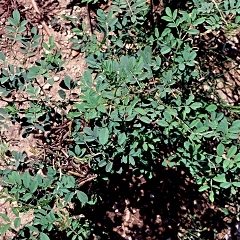 |
|
A small indigo plant, Indigofera tinctoria on the island of Lembata. Photo Peter ten Hoopen. |
|
Indigo
Indigofera is a nitrogen-fixing shrub that thrives in poor soils. A weaver will collect bushels full of leaves and soak them in water to release a blue dye called indican. After the soaking is completed the leaves are removed, and ground limestone, in coastal communities typically created from burnt seashells, is added; after which the solution turns a yellowish green and the bundles of tied threads can be immersed in it. Then the miracle happens, aided by some light stirring: by exposure to the air the indican oxidizes and turns blue, passing its colour to the threads - cotton fibre readily binding with indigo, with such strength that indigo cloth remains colourfast even after years of laundering.Indigo does degenerate over time, breaking up slowly, during which a chemical compound is created called scatol, that is also a created in our bodies and commonly found in excrement. Which is why old indigo cloth always has a slight smell that reminds one of a horse stable. Not necessarily unpleasant, but typical - and a good indicator of age. An indigo cloth that does not have this smell cannot be over thirty or forty years old.
Indigo is not just a pigment, it is also considered a material with magical, supernatural powers - powers to protect and to harm. Working with indigo for the dyers is fraught with danger. If the dyers make a mistake (an infringement of the traditional rules proscribing the correct way of preparing and using the dye) harm will surely come to them - at least this is their conviction. And as such convictions rarely fail to influence once conduct and health, accidents and other forms of suffering often result from erroneous or disrespectful work with this powerful plant. Minor damage may result from lesser infringements. The Sumbanese hold that if a man should enter the hut where the dyeing takes place, the threads will not accept the pigment. As such proscriptions are adhered to with almost religious rigor, nothing of course will ever occur that could test the truth of the superstition.
Repeated indigo dyeing produces a very dark blue that never reaches a true black. To make black, some weavers add tannin plants to their indigo vats, or overdye indigo with tannin and iron. The black mud in Rindi, East Sumba is particularly rich in iron and other minerals. Weavers in Rindi soak threads in mud-holes to obtain an even, colourfast black.
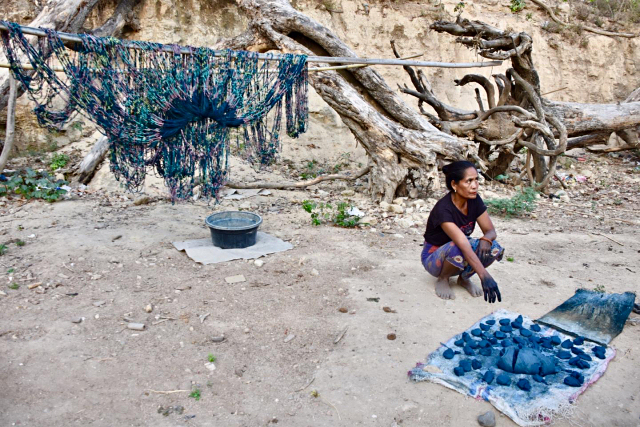 Skeins of cotton warp drying after steeping in indigo. The dyer has preserved some of the indigo in the form a cakes than will help get her next batch a deep tonality more quickly. Haumara village, East Sumba. Photo Serena Lee, Textile Odyssey Tours, 2017. This photo says 'indigo' more eloquentely than any other we are aware of and we are grateful for the gracious permission to use it.
Skeins of cotton warp drying after steeping in indigo. The dyer has preserved some of the indigo in the form a cakes than will help get her next batch a deep tonality more quickly. Haumara village, East Sumba. Photo Serena Lee, Textile Odyssey Tours, 2017. This photo says 'indigo' more eloquentely than any other we are aware of and we are grateful for the gracious permission to use it.
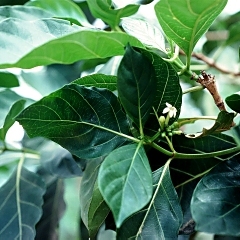 |
|
Morinda citrifolia bush in bloom on the island of Lembata. Photo Peter ten Hoopen. |
|
Morinda
Morinda is made by crushing and pounding the bark of the roots of morinda trees, steeping the pulp in water, putting it in a cloth and then wringing out the liquid to extra the red pigment, which is called morindin. Cotton is an ideal material for dyers to work with, because it naturally binds with many pigments, but morinda is not one of them, which is why a mordant needs to be use to make it adhere. The recipes for mordants are clan secrets, handed down through the generations from mother to daughter.Recipes across the archipelago differ slightly from one island to another, but they all use combinations of organic compounds that bind the morindin to the cotton fibre. Typical components are a vegetable oil made from candle nuts, Aleurites moluccana, tannin, which may be extracted from any of a whole range of wild plants, and aluminum salt, a chemical which may be extracted from the leaves and bark of trees in the Symplocos and Xanthophyllum families. These trees grow only at higher elevations, so dyers from lowland and coastal regions need to acquire them by trade, which can hold up the process of preparation for extended periods of time.
Morinda is especially meaningful to the Lamaholot people. No bridal exchange is complete without at least one kewatek mean, a sarong made exclusively with morinda, made with morinda, partly overdyed with indigo.
Mordanting and dying - a very slow process
Being held up for extended periods of time, by the way, is par for the course. It is quite normal for the whole mordanting and dyeing process to take from one to two years - before any weaving is done. Indigo flourishes only in the rainy season, whereas morinda roots can dug up only August and September at the height of the dry season. Harvesting the ingredients is further encumbered and slowed down by various taboos and proscriptions related to the moon calendar, menstrual cycles, and traditions which differ from region to region and clan to clan. But there is another reason for keeping the process from going fast: if the dyed cloths dry fast, the colour will not be very strong. This is particularly true of morinda. Therefore the weavers in some areas, including East Sumba will leave threads that have been steeped in mordant out overnight to take the dew, while keeping them shaded by day.The dyeing process is often repeated a number of times to achieve depth of colour. The Ngadha will steep their threads in indigo bath up to ten times, and for very long period. The East Sumbanese, who like their reds vibrant, do the same with morinda. Weavers in the Lio and Endeh regions of Flores like their reds dark like aubergine or brown like chestnut, and achieve this effect to dip the cloth in a hot solution made from sappan wood, Caesalpinia sappan.
